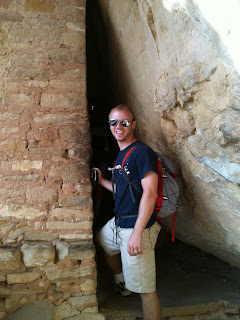30 miles west of Durango, CO, lie the sandstone plateaus of Mesa Verde National Park. Tucked away in the alcoves under the green plateaus are the Cliff Dwelling homes of the ancient Pueblo people of the Southwest, hidden to the world because of their location until the late 1800s. Dylan and I spent a full day climbing up and down the plateaus (8000 ft. elevation) in order to reach the various dwellings available for guided and self-guided tours. The Pueblo people first lived on top of the mesas, moving into the cliff dwellings only in the 1200s. They were subsistence farmers with a diet based on corn, turkey, squash and beans. The women were famous for their basket weaving, which has been found as far south as Mexico and west as California. The Pueblos kept no written records and left quite rapidly in the early 1300s, most likely due to a 23 year drought the area encountered.
Our first tour: Balcony House, the most "dangerous" of the dwellings because of its' steep entry way and tunnel exit.
600 ft. above the canyon floor, view from the Soda Canyon Trail across the canyon gulf
32 ft. high ladder entrance way
Next stop was the most famous of all the dwellings: Cliff Palace, discovered in 1888. It is the largest of all the dwellings with over 150 rooms and 23 kivas, set among 3 layers of rock.
100 ft. below the Mesa top
The large holes in the ground are called KIVAS. They were used as multi-purpose rooms, mostly for religious ceremonies (Kachina Worship); however, some evidence suggests the Pueblos slept and ate in these rooms as well during the colder months. 5-6 families would share one Kiva. Hole in the floor is for a fire pit with the stone block in front of the pit to circulate cool air from outside. Generally, the Kiva would be covered with a wooden and stone roof but due to weather and people, those were the first to be destroyed.
Next stop: Spruce Tree House
This dwelling contains 114 rooms and is the best preserved site in the whole park. Park people recovered a Kiva, allowing visitors to climb down a ladder and get a feel for the "true" atmosphere of a Kiva back in the 1200s.
The temperature was quite cool inside the Kiva and without a fire or natural light from the roof hole, would have been pitch black. Not gonna lie, it was a little too small for me to think about sleeping with 10-12 other people who had not bathed recently. I would have built my own Kiva, hehe!
Next stop: lunch and a cool-off session inside the Chapin Mesa Museum
700 year old corn!!!
Chapin Mesa Top Loop Trail takes you in a 5 mile circle, showcasing sites found on top of the Chapin Mesa while offering great views of cliff dwellings. We drove this one, getting out at each stop to explore and take pictures.
Tower House
Oak Tree House
Ended the day getting all kinds of free stuff from the park service because I just "happened" to mention to the Ranger I was plying with questions that I was a high school history teacher; I "so wished" my students could come to see this. Mwahah! Amazing what you can get when you use the word "teacher."




















No comments:
Post a Comment